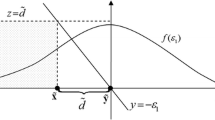Abstract
This study is concerned with the problem of measuring average distances between two points in two different coplanar regions. The objectives are: (1) to derive the approximated average distances associated with circular regions and to check their accuracy; and (2) to apply these approximated distances to location problems. Results show that the simple approximate formulas are accurate and useful. The approximated average distances can be applied to the analyses of varied kinds of movement phenomena in cities.
Similar content being viewed by others
References
D. Bennett and A. Mirakhor, “Optimal facility location with respect to several regions,”Journal of Regional Science 14 (1974) 131–136.
C.J. Bouwkamp, “On the average distance between points in two coplanar non-overlapping circular disks,”Journal of Applied Science and Engineering, A 2 (1977) 183–186.
P.A. Casillas, “Data aggregation and the p-median problem in continuous space,” in: A. Ghosh and G. Rushton, eds.,Spatial Analysis and Location—Allocation Models (Van Nostrand Reinhold, New York, 1987) 327–344.
L. Cooper, “Location—allocation problems,”Operations Research 11 (1963) 331–343.
L. Cooper, “A random locational equilibrium problem,”Journal of Regional Science 14 (1974) 47–54.
B. Ghosh, “Random distances within a rectangle and between two rectangles,”Bulletin of Calcutta Mathematical Society 43 (1951) 17–24.
T. Koshizuka, “Contributions to the theoretical study of urban spatial structure,” Doctoral Dissertation, University of Tokyo (Tokyo, 1977). [In Japanese.]
T. Koshizuka and O. Kurita, “Population estimation and calculation of the average distance to a facility using the grid system data,”Papers of the Annual Conference of the City Planning Institute of Japan 19 (1983) 319–324. [In Japanese.]
O. Kurita, “Approximated formulas of average distances associated with regions and their applications to urban analyses,” Doctoral Dissertation, University of Tsukuba (Tsukuba, 1989a). [In Japanese.]
O. Kurita, “Average distances associated with radially symmetrically populated regions,”Papers on City Planning (City Planning Institute of Japan) 24 (1989b) 331–336. [In Japanese.]
O. Kurita and T. Koshizuka, “Approximated formulas of average distances and their applications,”Papers on City Planning (City Planning Institute of Japan) 23 (1988) 43–48. [In Japanese.]
R.F. Love, “A computational procedure for optimally locating a facility with respect to several rectangular regions,”Journal of Regional Science 12 (1972) 233–242.
P.A. Schweitzer, “Moments of distances of uniformly distributed points,”American Mathematical Monthly 75 (1968) 802–804.
G. Strang, “Introduction to applied mathematics (Wellesley-Cambridge Press, Cambridge, MA, 1986).
R. Vaughan, “Approximate formulas for average distances associated with zones,”Transportation Science 18 (1984) 231–244.
Author information
Authors and Affiliations
Rights and permissions
About this article
Cite this article
Koshizuka, T., Kurita, O. Approximate formulas of average distances associated with regions and their applications to location problems. Mathematical Programming 52, 99–123 (1991). https://doi.org/10.1007/BF01582882
Received:
Revised:
Issue Date:
DOI: https://doi.org/10.1007/BF01582882




